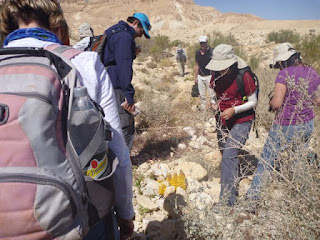23/3/2016
Viagem de campo para Nahal Zin (Ein Sharav) com
·
Lisa Boaretto - Weizzman
·
Steve Weiner – Weizmann
·
Mae Goder – Ben Gurion
·
Yoav Avni - IGS
·
Omry Barliai – Israel Antiquities
Viagem
demorou 3 hs em cada sentido.Esse foi o ultimo campo efetuado pelo grupo, que e
composto de colaboradores de varios institutos para estudar a viabilidade do
projeto. Nao e possivel coletar nenhm material arqueologico do sitio. Somente
quando houver um projeto aprovado e possivel coletar amostras.
Steve e Lisda nunca tinham vindo a
regiao. E a area de passagem do homem da Africa para a Asia ha 50.000 anos
atras. De acordo com Mae, e o site mais famoso. Na dexada de 70 area proxima foi estudada por americano.
Conjunto de terracos divididos morfologicamente
e por datacao OSL – mais de 100 datacoes
· Q3
youngest – ate 60.000 anos
· Q2
middle
· Q1
Oldest
Calcario com muitas concrecoes de
flint – que pode ter sido originado de diatomaceas e radiolarias. Existe tambem
no Q2 uma camada consideravel de flint.
O flint e o tipo de rocha utilizado
para os artefatos arqueologicos: ex, flechas. A questao e se esses fragmentos
de flint sao resultados de erosao e fill in do valley ou se sao fragmentados in
situ.
Grandes camadas de loess, em muitos
casos sem outra granulacao mais grossa, e outros com congromerados. Yoav
mencionou que muitas pessoas estudam a procedencia do Loess na regiao. Pode ter
originado da Arabia Saudita, ou do Saara. Nos ultimos anos ocorreu uma
tempestade de loess em Israel de proveniencia
da Arabia Saudita.
Apesar da aparencia do Flint, nao ha
ventifacts nessa area. O vento nao e fore suficiente.
Camadas inclinadas de 20-30 graus nao
sao tectonicas, sao de escorregamento.
Mapeamento de Israel todo
em 1:50.000, estao comecando 1:10.000 em algumas areas.
Aparecem algumas estruturas de bronze
age na area, essas poderiam ser escavadas, mas nao sao o foco do estudo

O foco do estudo e o Paleolitico.
Oldowan (2.6–1.7 Ma)
Riwat (1.9–0.045 Ma)
Soanian (0.5–0.13 Ma)
Acheulean (1.8–0.1 Ma)
Clactonian (0.3–0.2 Ma)
Mousterian (600–40 ka)
Micoquien (130–70 ka)
Aterian (82 ka)
Baradostian (36 ka)
Châtelperronian (41–39 ka)
Aurignacian (38–29 ka)
Gravettian (29–22 ka)
Solutrean (22–17 ka)
Magdalenian (17–12 ka)
Hamburg (14–11 ka)
Federmesser (14–13 ka)
Ahrensburg (12–11 ka)
Swiderian (11–8 ka)
The Paleolithic (American spelling; British spelling: Palaeolithic; pronunciation: /ˌpeɪliəˈlɪθɪk, ˌpæ-, -lioʊ-/[1]) Age, Era or Period is a prehistoric period of human history distinguished by the development of the most primitive stone tools discovered (Grahame Clark's Modes I and II), and covers roughly 95%[2] of human technological prehistory. It extends from the earliest known use of stone tools, probably by Homo habilis initially, 2.6 million years ago, to the end of the Pleistocene around 10,000 BP.[3]
The Paleolithic era is followed by the Mesolithic. The date of the Paleolithic–Mesolithic boundary may vary by locality as much as several thousand years. During the Paleolithic period, humans grouped together in small societies such as bands, and subsisted by gathering plants and fishing, hunting or scavenging wild animals.[4] The Paleolithic is characterized by the use of knapped stone tools, although at the time humans also used wood and bone tools. Other organic commodities were adapted for use as tools, including leather and vegetable fibers; however, due to their nature, these have not been preserved to any great degree. Surviving artifacts of the Paleolithic era are known as paleoliths.
About 50,000 years ago, there was a marked increase in the diversity of artifacts. For the first time in Africa, bone artifacts and the first art appear in the archeological record. The first evidence of human fishing is also noted, from artifacts in places such as Blombos cave in South Africa. Firstly among the artifacts of Africa, archeologists found they could differentiate and classify those of less than 50,000 years into many different categories, such as projectile points, engraving tools, knife blades, and drilling and piercing tools. The new technology generated a population explosion of modern humans which is believed to have led to the extinction of the Neanderthals.[5][6]
Humankind gradually evolved from early members of the genus Homo such as Homo habilis – who used simple stone tools – into fully behaviorally and anatomically modern humans (Homo sapiens) during the Paleolithic era.[7] During the end of the Paleolithic, specifically the Middle and or Upper Paleolithic, humans began to produce the earliest works of art and engage in religious and spiritual behavior such as burial and ritual.[8][9] The climate during the Paleolithic consisted of a set of glacial and interglacial periods in which the climate periodically fluctuated between warm and cool temperatures. Archaeological and genetic data suggest that the source populations of Paleolithic humans survived in sparsely wooded areas and dispersed through areas of high primary productivity while avoiding dense forest cover.[10]
By 40,000-50,000 BP, first humans set foot in Australia. By 45,000 BP, humans lived at 61° north latitude in Europe.[11] By 30,000 BP, Japan was reached, and by 27,000 BP humans were present in Siberia above the Arctic Circle.[11] At the end of the Upper Paleolithic, a group of humans crossed the Bering land bridge and quickly expanded throughout North and South America.
The term "Paleolithic" was coined by archaeologist John Lubbock
in 1865.[12] It derives from Greek: παλαιός, palaios, "old"; and λίθος, lithos, "stone", meaning
"old age of the stone" or "Old Stone Age."












































































Nenhum comentário:
Postar um comentário